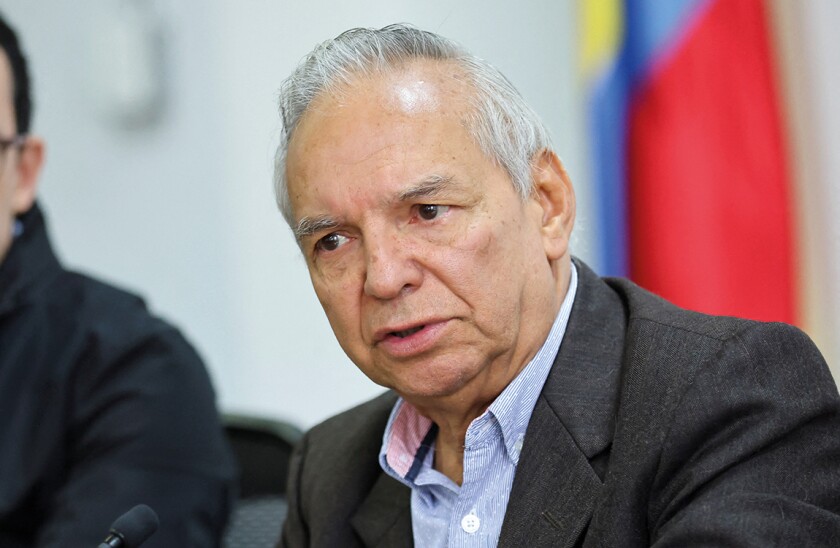Emerging nations are continuing to deal with being shunned by capital markets, as soaring Treasury yields have made them collateral damage in the US’s battle against inflation. Even the strongest developing economies’ funding costs are painfully high. For high yield borrowers the risk of default is rising, unless there is a sharp about-turn in US rates.
“Our message to the market and to the international community is that you cannot drown us with interest rates,” Ricardo Bonilla, Colombia’s finance minister, told GlobalMarkets. “High rates not only take away our fiscal space but they take away our space for investment.”
Things are not going his way. On Thursday, US inflation for September came in at 3.7% — again above consensus. Two days earlier, in its World Economic Outlook, the IMF revised its US growth forecast for 2024 upwards — from 1% in July to 1.5%.
Having been calmer earlier in the week as some Fed board members made more dovish comments, the 10 year Treasury yield — which had already soared since the beginning of September — rose 9bp on Thursday morning New York time, to around 4.65%.
Higher US interest rates are making dollar borrowing extremely expensive for stronger emerging markets, and have left lower-rated nations locked out of the markets.
The average spread for a speculative grade-rated country in JP Morgan’s EMBI index is around 12% — a level prohibitively high for bond issuance.
“The debt sustainability question is still with us,” Kaan Nazli, EM sovereign bond portfolio manager at Neuberger Berman, told GlobalMarkets in Marrakech. “If US Treasury yields stay in the 4.5% to 5% area for another two or three years, there could be more defaults, or you’ll see private debt move to the hands of the official sector, in the form of more IMF programmes and bilateral financing.
“With this comes fiscal consolidation, which hurts growth. For EM fixed income it will be a more difficult two or three years than before.”
EM debt experts are beginning to ask how long developing countries can sustain these kinds of yields, said Nathalie Marshik, managing director in Latin America fixed income at BNP Paribas.
“As a finance minister or an IMF official you’re probably looking at the global debt numbers and saying ‘if the market stays as it is, how do EMs get through 2024? How do they refi?’” she said. “In Latin America, the 2024 maturities are not so bad, but in the rest of EM there are big questions.”
Stress across the board
A particular spike in external bond maturities is looming in Africa, where Zambia and Ghana have already defaulted and around $10bn is due in each of 2024 and 2025.
But even EMs with ample financing options are facing acute pressure. “You’ve got a situation now where debt levels are high and cheap financing has stopped, and that means austerity,” said Charlie Robertson, head of macro strategy at FIM Partners UK. “[These are] hard times, and we’re seeing that in Egypt, Kenya, Nigeria and Angola. There’s no there’s no easy way out.”
Recent new issuance in Latin America shows how expensive debt has become. Investment grade Panama, which two years ago paid 3.77% for a 30 year bond, in late September issued 12 year paper at 6.98% and 30 year at 7.45% — the most it has paid since 2007. The 7.05% Guatemala offered on the same day was its highest since 2004.
Colombia may issue in dollars soon, having roadshowed its new sustainable bond framework earlier in September. Based on the secondary market prices of its international bonds, it would likely have to pay its highest yield for many years.
“We have found some cheaper financing alternatives [than bond markets], but you can’t always find them,” said its finance minister Bonilla.
Emerging economies are having to pay more to finance growing deficits.
Andrés Perez, chief Latin America economist at Brazilian bank Itaú, said that despite Lat Am economies having so far managed higher rates reasonably well, his main concern was that “tight global financial conditions have become even tighter”.
“This scenario is very challenging for EMs,” he said. “Financing needs remain substantial in Latin America, [and] this is happening at a point in the cycle when many economies are slowing, so deficits may become even larger.”
The pain goes beyond dollar bond markets, as higher US rates have forced EM central banks to raise their own rates.
“We have a very challenging environment,” Ibrahim Stevens, acting governor of the Bank of Sierra Leone, told GlobalMarkets. “Inflation is soaring — passing 50% in August. The central bank has hiked rates to just over 21%, but this hurts the poorest sections of society.
“The transmission mechanism means that as interest rates increase internationally that affects imports into the country, and that [drives] inflation, which then leads us to tighten policy even more,” he said. “It’s problematic.”
